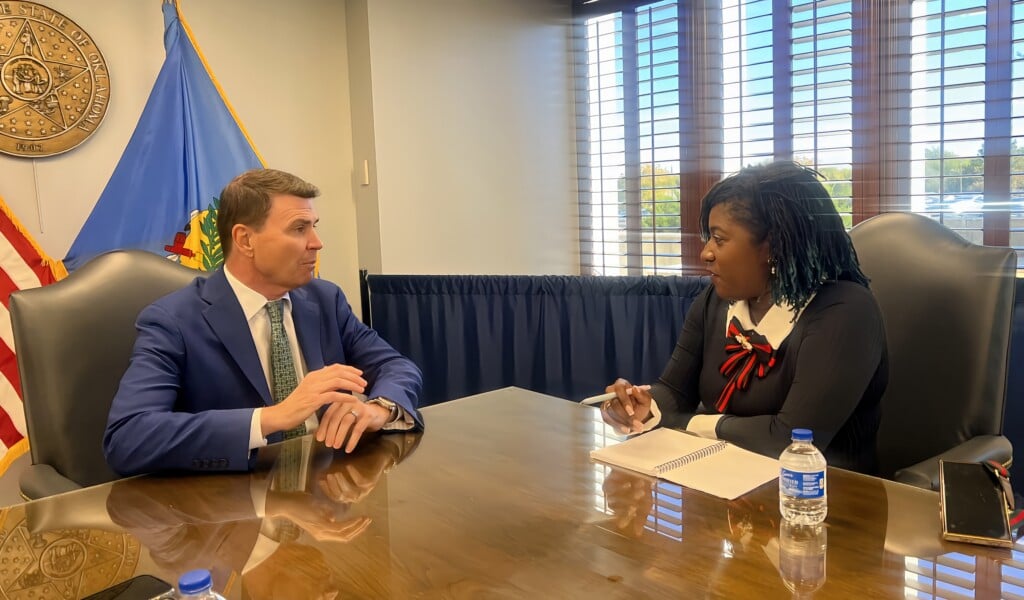Walking the Halls of Hope
A Visit with Interim Oklahoma State Superintendent of Public Instruction Lindel Fields

When families, educators and school leaders across Oklahoma walked into classrooms this fall, many felt like survivors emerging from a long storm. Behind the smiles, lesson plans and back-to-school excitement, a quiet mix of fatigue, doubt and heartbreak lingered — the residue of three intense years that left teachers unseen, districts stretched thin, and parents questioning whether the system still had their backs.
What so many of us have been living through is EduPTSD™. It’s the quiet weariness teachers, parents and even students carry after years of shifting mandates, public scrutiny and relentless demands to perform without real support. We’ve kept showing up — lesson after lesson, meeting after meeting — determined to hold things together. But beneath that dedication is a fatigue no long weekend can fix. EduPTSD™ isn’t about fragility; it’s about what happens when a system keeps asking for excellence from people already running on fumes. And yet, even through that exhaustion, a glimmer of hope is returning — the kind you feel when a new chapter begins and the air in the building just feels different.
The Walk: Hallway Healing
When Gina Wilson, principal of East Central High School, and I entered the Oklahoma Department of Education office in Oklahoma City, we were greeted with a warm smile and a joke from the security guard. It felt like an exhale we didn’t realize we were holding. After years of tension and guarded interactions, that simple welcome meant something. After passing security, we were met by Bailey, the communications director, who guided us to the boardroom. But before we reached it, Gina and I stopped mid-stride. The Educator Hall of Fame photos — once removed under Ryan Walters — were back on the wall. Framed portraits of Oklahoma’s most dedicated educators once again lined the hallway.
We paused, asked Bailey if we could take a moment, and she smiled: “Take as long as you need.” Standing there reading the names felt like a quiet reminder that people were being seen again.
As we entered the boardroom, Jackie, Superintendent Fields’ executive assistant, greeted us with a warm hug. It wasn’t just professional courtesy — it was care. The feeling was indescribable, the kind you can’t stage or script. After years of operating in fight-or-flight mode, we felt safe enough to simply breathe.
From Vo-Tech Student to The State Department of Education Superintendent
When Superintendent Lindel Fields walked into the room, it wasn’t with the air of a politician, but of someone who had spent years in the trenches. A former vo-tech student himself, Fields once studied horticulture at what is now known as Tulsa Tech, while Dr. Joe Lemley served as superintendent. He didn’t set out to run a statewide agency or even imagine holding this office after retiring from a 19-year tenure leading Tri-County Tech. But history has a way of calling people who understand what’s at stake.
The Blueprint for Renewal
As I spoke with Superintendent Lindel Fields, he shared four core areas he intends to focus on to put Oklahoma’s education system back on track. The areas include respect, access, rebuilding and elevation.
Restoring Respect
“I didn’t come here to add more mandates,” Fields told me. “I came to rebuild trust.”
Fields believes that recovery begins with respect. “You can’t rebuild education from the top down,” he said. “You start with the people who make the system work.”
His focus isn’t just on filling vacancies, but on restoring the professional dignity that once made teaching a calling rather than a cautionary tale. That means listening to educators before legislating, recognizing paraprofessionals as essential to the learning process, and ensuring that new teachers have mentors instead of merely relying on manuals.
Expanding Access and Instruction Time
Fields discussed Oklahoma’s teacher shortage and the increasing number of emergency-certified educators entering the classroom. In 2013–14, Oklahoma issued 189 emergency teaching certificates; by 2023–24, that number had surged to 4,676. He noted that colleges are graduating fewer students with teaching degrees, leaving schools to rely more heavily on individuals entering the profession through alternative routes.
“We hear about emergency certifications, and we put a bit of a stigma on that,” Fields said. “But that may be our reality. So, what can we do to prepare those folks who are coming in at different times and may only want to teach for 10 or 15 years? If they’re going to be with us 10 years, let’s embrace that, but make them really good while they’re here.”
For Fields, access means providing every educator—regardless of how they enter the profession—with the mentorship, training and respect they need to succeed.
When our conversation turned to student learning, Fields smiled and said, “Now, this next one—my daughter’s not going to like it.” He laughed, referring to increasing instructional time. “If we want better outcomes,” he continued, “we have to give students more meaningful time to learn.”
Across the country, higher-performing states average around 1,170 to 1,200 instructional hours per year, while Oklahoma requires 1,080. That gap might not sound large on paper, but in practice, it equals several weeks of missed opportunities for growth each school year.
Rebuilding Workforce Pipelines
Fields sees Oklahoma’s CareerTech network as a vital part of the solution for building an effective workforce. He understands that when students can connect classroom learning to real-world careers, it not only strengthens the economy but also helps cultivate future educators, industry leaders and innovators. He believes the system must evolve to prepare learners for both immediate employment and lifelong growth. In his eyes, rebuilding the pipeline isn’t about creating a new system — it’s about reigniting pride and purpose in the one that already exists.
Elevating Student Success and Community Partnership
Literacy sits at the heart of the basics. Oklahoma’s most recent assessments show that fewer than one in four students is proficient in reading by fourth grade — a number Fields believes can’t improve without strong classroom leadership and early intervention.
“Teaching is the most noble of all professions,” he said. “And it’s not just teachers; it’s every educator who touches a child’s life — bus drivers, cafeteria workers, paraprofessionals. They all shape the learning experience.” He’s convinced that meaningful change requires collaboration beyond the school walls.
Superintendent Fields isn’t offering quick fixes; he’s offering steadiness and a plan for the long haul. Leadership grounded in listening, humility and human connection. Maybe that’s what this new chapter in Oklahoma education is truly about: healing from EduPTSD™ by rebuilding trust, one conversation, one student and one relationship at a time.
 Dr. Tamecca Rogers serves as Director of Student Access and Success at Tulsa Technology Center. An award-winning author and filmmaker, she is committed to diversity, equity and inclusion in all her endeavors. Photo by Denice Toombs-Dotson with Lasting Impressions Photography.
Dr. Tamecca Rogers serves as Director of Student Access and Success at Tulsa Technology Center. An award-winning author and filmmaker, she is committed to diversity, equity and inclusion in all her endeavors. Photo by Denice Toombs-Dotson with Lasting Impressions Photography.



